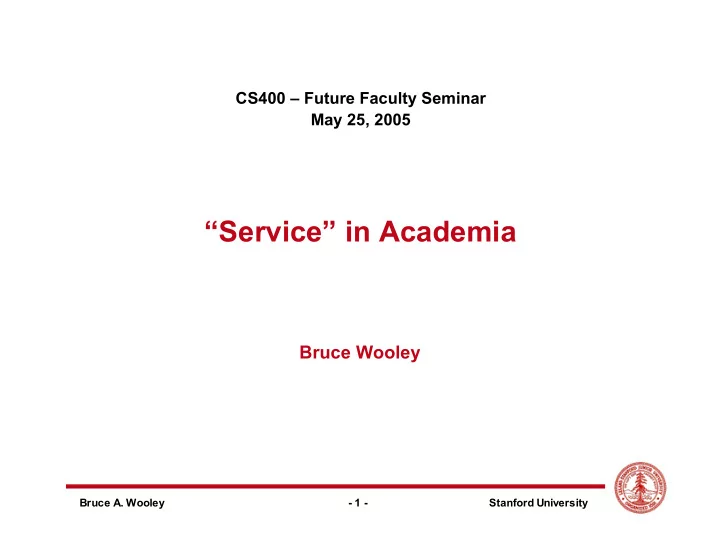

CS400 – Future Faculty Seminar May 25, 2005 “Service” in Academia Bruce Wooley Bruce A. Wooley - 1 - Stanford University
How Did I Get Here? Ph.D. from Berkeley in 1970 14 years in Research at Bell Labs – Left because Stanford asked, and I liked working with students and recent graduates Joined Stanford in 1984 – (tenure the easy way) ICL Director 93-96 – Because Jim Plummer became Senior Assoc. Dean Since 1996: EE Chair, Senior Assoc. Dean & EE Chair – Because John Hennessy and then Jim Plummer were Dean Bruce A. Wooley - 2 - Stanford University
Professional Activities Journal of Solid-State Circuits Guest Editor (1975) Int’l Solid-State Circuits Conf Chair (1981) JSSC Associate Editor JSSC Editor VLSI Symposium Chair Solid-State Circuits Council/Society AdCom SSC Society President Bruce A. Wooley - 3 - Stanford University
What Kind of “Academic” Career? Are you driven by 1. Classroom teaching? 2. Mentoring the research of PhD students? 3. Personal research? At a top-tier research university (i.e. Stanford), #2 is the most important Bruce A. Wooley - 4 - Stanford University
At a Research University Young faculty must establish external visibility for research contributions Good teaching is necessary, but not sufficient Service to the institution won’t count for much early on In the long term, external relationships are key to sustaining a research program Bruce A. Wooley - 5 - Stanford University
Service to Research Community Reviewing papers & program committee service help establish visibility, and should broaden knowledge base Avoid service with a large, ongoing time commitment until mid career – e.g. conference chair or journal editor (which require capable administrative support) – guest editor for single issue is good Bruce A. Wooley - 6 - Stanford University
Service to Institution Department level committees – Don’t spend too much time being a good citizen – Some committees are good, w/o heavy time commitment • e.g. Academic Administration Committee in EE – Admissions Committee can help you find good students early, but is a large time commitment for a couple of months University service – Avoid until tenured Bruce A. Wooley - 7 - Stanford University
Academic Administration Hierarchy – President – Provost – Deans – Department Chairs President and deans focus is often external & strategic – Fund raising, strategic planning, capital investment, alumni and community relations – The “face” of the institution Provost and department chairs deal primarily with internal issues – Appointments & promotions, operating budget, resource allocation, academic affairs Bruce A. Wooley - 8 - Stanford University
Administration If administration appeals to you, why do you want be an academic? – A university is not a place that can be “managed” – Asking for help works a lot better than trying to tell people what to do For administrative tasks, often ask people who are reluctant – Already have many responsibilities – Must give up something (research, teaching?) – Willingness to “serve” Bruce A. Wooley - 9 - Stanford University
Most Important Tasks Department Chairs – Appointment of new faculty Deans – “Appointment and promotion of faculty” Provost – “Appointment of deans” (from Provost at another top- tier research university) At all levels, devoted to supporting the academic mission, but research programs depend largely on individual faculty initiative Bruce A. Wooley - 10 - Stanford University
What is Most Important? Integrity & Fairness Bruce A. Wooley - 11 - Stanford University
Recommend
More recommend